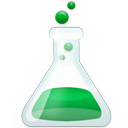Acquiring an IR Spectrum
The organic chemistry teaching labs at CU Boulder have 4 Nicolet FT-IR instruments: an Avatar 320, an Avatar 370, and two IR 200s. There is one in the instrument room attached to each of the lab rooms. If the instrument in your lab has a long line, you can also use the one in M1B70.
 |
||
| Avatar 320 - Located in M1B25. | Avatar 370 - Located in M1B70. | IR 200 - Located in M1B27 and M1B73. |
Acquiring a Spectrum
 |
First, prepare your sample as directed in the liquid sampling technique or solid sampling technique pages. Most likely, the EZOMNIC program has already been launched, a background run, and is ready to go - in this case, you can skip to the sample collection step. If not, double-click the icon for the program. |
 |
Run a background. First, make sure there are no plates in the IR, then click on the Col Bkg icon in the upper tool bar. |
 |
Wait for the instrument to run four background scans. This is necessary because it provides a baseline that the instrument will subtract out of subsequent scans - it's a way to compensate for the presence of water, CO2, impurities in salt plates, etc. |
 |
If you have scanned the background properly, this is what it looks like. If it does not look like this, for instance, if it has a lot more bands, you probably left IR plates in the instrument when you took the background. |
 |
Place the salt plate(s) in the instrument. Click on the icon in the upper toolbar that says "Col Smp" to collect the sample. |
 |
Your spectrum should appear after a few seconds. |
 |
If it looks like this, for instance, if it is a straight or jaggedy line, someone probably left a sample in the instrument when the background was run. You'll need to collect a fresh background. |
 |
If you are happy with your spectrum, you can print to the default printer for your lab. |
Back to IR Spectroscopy
